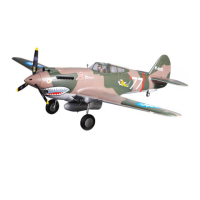
Do you have a question about the FMS P-40B flying tiger and is the answer not in the manual?
| Motor size | 3648-KV770 |
|---|---|
| Motor type | Brushless |
| Engine type | Electric engine |
| Flight time | 5 min |
| Product type | Airplane |
| Servo weight | 9 g |
| Difficulty level | Intermediate |
| Housing material | Expanded Polyolefin (EPO) |
| Number of servos | 4 |
| Assembly required | Yes |
| Channels quantity | 6 channels |
| Construction type | Plug-N-Play(PNP) |
| Recommended age (min) | 14 yr(s) |
| Battery voltage | 14.8 V |
| Battery capacity | 2600 mAh |
| Assembly time | 45 min |
| Product color | Brown, Green |
| Length | 825 mm |
|---|---|
| Weight | 1240 g |
| Wingspan | 980 mm |
| Center of Gravity (CG) | 45 mm |
User responsibility for safe operation, radio interference, and avoiding collisions or injury.
Thank you for purchase, customer service, contact info for suggestions.
CAUTION on mishandling, charging, storage, and usage of Li-Po batteries.
Use of appropriate chargers, heat-resistant surfaces, and fire-resistant bags for charging.
Contact information for FMS Team product support.
Lists essential tools, transmitter/receiver, battery/charger, and motor/ESC/servos.
Connecting aileron and flap control rod linkages to servo arms and control horns.
Steps for installing the main wing onto the fuselage, including servo lead routing.
Guide for attaching the horizontal stabilizer halves using a connecting tube.
Connecting elevator linkages and routing receiver connections with Y-harness.
Instructions for installing and securing the flight battery within its compartment.
How to check and correct motor rotation direction (counterclockwise).
Procedure for centering control surfaces using transmitter trims and clevis adjustments.
Verifying control surface response direction via transmitter stick movements.
Specifies low rate throw settings for ailerons, elevator, rudder, and flaps.
Guidance on using dual rates for different flying styles.
Steps for test fitting and gluing machine gun sets onto the wing.
Optional step to slide the external fuel tank into the fuselage slot.
Covers pre-flight checks, flight safety guidelines, and daily checks before/after flying.
Details on ESC specifications, model numbers, and key operational features.
Overview of programmable settings like brake, battery type, and low voltage cutoff.
Configuration for timing, acceleration, motor rotation, and switching frequency.
Interpretation of audible alert tones and built-in safety features like overheat protection.
Steps for automatic throttle calibration, normal startup, and programming mode entry.
Crucial safety guidelines for ESC usage, polarity, ventilation, and battery connections.
Diagnosing problems like motor not working, no tones, or incorrect tones.
Troubleshooting motor issues with servos working or specific alert tones.
Diagnosing reverse rotation, stopping, and abnormal restart problems.
Addressing ESC overheating due to ventilation, servo load, or motor/prop size.